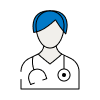If your liver is healthy, there should be little or no fat in it. However, sometimes, fat molecules called triglycerides begin to collect in your liver cells. Small amounts of fat in your liver usually cause no problems. However, when too much fat builds up, this is called fatty liver disease.
Types of fatty liver
There are two main types of fatty liver disease.
- Alcoholic liver disease, which is caused by drinking too much alcohol.
- Non-alcoholic fatty liver disease, which is caused by other conditions, such as diabetes or being overweight.
Fatty liver disease is becoming one of the most common types of liver disease and can sometimes lead to serious health problems. It's now as common as alcohol as a cause of liver cirrhosis. Around one in three people are thought to have some degree of non-alcoholic fatty liver disease. Non-alcoholic fatty liver disease is more common in men than in women, and is more likely to be diagnosed in people with diabetes and those over 50.
Fatty liver disease can lead to an inflamed liver and scarring. This is called alcoholic hepatitis if it's caused by drinking too much alcohol and non-alcoholic steatohepatitis (NASH) if it's not related to alcohol. Both of these conditions can eventually lead to cirrhosis, which can be life-threatening. Fatty liver disease can also lead to liver cancer.
Causes of fatty liver
There are a number of things that can cause fatty liver disease. The two main ones are:
- drinking too much alcohol
- being overweight or obese – this makes it more likely that you will develop conditions such as diabetes or high cholesterol, both of which can also cause fatty liver disease
There are other things that can cause fatty liver disease, including some medicines and rapid weight loss, but these are less common.
Acute fatty liver disease is a very rare complication that can develop during the last three months of pregnancy. It can lead to liver failure if it's not treated quickly. If you're pregnant and develop symptoms such as abdominal pain, being sick and yellow whites of your eyes and skin, you should contact your doctor straight away.
Symptoms of fatty liver
Fatty liver disease often has no symptoms, particularly when it's mild. However, you may feel tired, or have pain and discomfort where your liver is – on the right side of your body just under your ribs. This pain is caused by a growing amount of fat inside your liver, which makes it expand, stretching the sensitive membrane that covers your liver.
As fatty liver disease progresses, your liver may become scarred and develop cirrhosis. If you develop cirrhosis, you may notice other symptoms such as:
- a swollen abdomen (tummy)
- itchy skin
- vomiting and bringing up or passing blood
- bruising easily
- confusion or poor memory
- weakness and muscle wasting
- yellow whites of your eyes and skin (jaundice)
If you develop any of these symptoms, contact your doctor straight away.
Diagnosis of fatty liver
Your doctor will ask you about your symptoms and examine you. He or she may also ask you about your medical history. It's important to be honest about your lifestyle and the amount of alcohol you drink, as this will help your doctor make the right diagnosis. Fatty liver disease can sometimes be difficult to diagnose because you may not have any symptoms.
Your doctor may ask you to have a blood test to check how well your liver is working. You may have other blood tests to find the cause of your symptoms or to rule out other possible causes.
You may be referred to a hepatologist, a doctor who specialises in conditions affecting your liver. There is no single test that can be used to diagnose fatty liver disease, but he or she may carry out some of the tests listed below.
- Ultrasound or scan. An ultrasound, CT scan or MRI scan can all be used to create images of your liver. These images will show any fat in your liver.
- Fibroscan. This is similar to an ultrasound scan – it can help to show any scarring of your liver.
- Liver biopsy. This is the only way to confirm how much damage there is to your liver. A biopsy is a small sample of tissue. It's taken using a very fine hollow needle that is inserted into your liver under local anaesthetic. The sample is then sent to a laboratory for analysis.
Treatment of fatty liver
If you have alcoholic liver disease, it's essential that you stop drinking alcohol. If you don's stop drinking alcohol, fatty liver disease can develop into alcoholic hepatitis and then cirrhosis in the future. If you stop drinking, it's likely that your liver will recover from fatty liver disease and hepatitis. To make sure you get the right support to help you to stop drinking, talk to your doctor.
If you have non-alcoholic liver disease, there is no specific treatment for it. However, making changes to your lifestyle can help to reduce the amount of fat in your liver. Losing excess weight, increasing the amount of activity you do and treating other conditions, such as diabetes and high cholesterol, can all help to reduce the amount of fat in your liver.
Prevention of fatty liver
You may be able to prevent non-alcoholic fatty liver disease by:
- maintaining a healthy weight for your height
- being active – try to do at least 150 minutes of moderate exercise each week, in bouts of 10 minutes or more
- eating healthy foods that are low in saturated fat
You can help to prevent alcoholic liver disease by following the recommendations for safe drinking. This means drinking no more than three to four units of alcohol a day if you're a man, and no more than two to three units a day if you're a woman. A unit of alcohol varies, depending on the strength of what you're drinking. However, one unit is about 25ml of spirit, half a 175ml glass of wine or half a pint of average strength beer, lager or cider.
Disclaimer
This information was published by Bupa Group's Health Content Team and has been reviewed by appropriate medical or clinical professionals. To the best of their knowledge the information is current and based on reputable sources of medical evidence, however Bupa (Asia) Limited makes no representation or warranty as to the completeness or accuracy of the Content.
The information on this page, and any information on third party websites referred to on this page, is provided as a guide only. It should not be relied upon as a substitute for professional medical advice, nor is it intended to be used for medical diagnosis or treatment. Bupa (Asia) Limited is not liable for any loss or damage you suffer arising out of the use of, or reliance on, the information.
Third party websites are not owned or controlled by Bupa and any individual may be able to access and post messages on them. Bupa is not responsible for the content or availability of these third party websites. Last updated August 2017.









